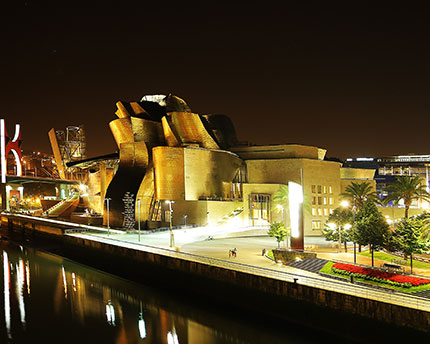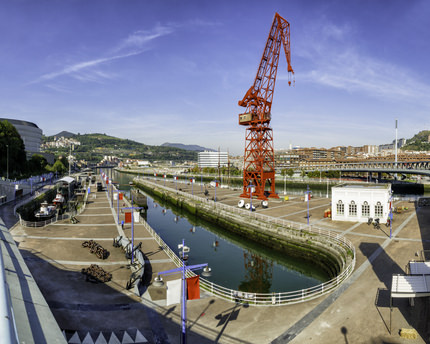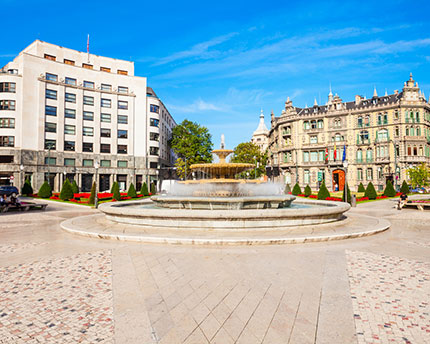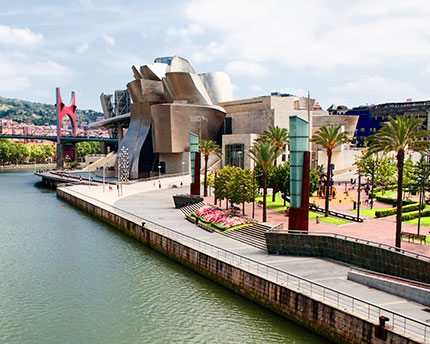Abando
Bilbao’s oldest residents know that Abando (or San Vicente de Abando) was an elizate or an independent municipality of the province of Biscay before becoming the sixth district of Bilbao. It was only during the successive expansion of the Basque capital in the late nineteenth century—as a result of its rapid industrialisation—that it was permanently annexed. With a population of approximately 50,000 inhabitants, distributed between Abando and Indauchu (the two neighbourhoods that make up the district), the area was once the base of numerous industries generally dedicated to the production of iron and steel. The decline in industrial expansion in the region in the late 1970s caused its deterioration, giving rise to the project Bilbao Ría 2000, which has transformed the decaying district into an area geared towards the tourism and services sector, with the Guggenheim Museum as its emblem.
Gran Vía Don Diego López de Haro, named in honour of the founder of Bilbao, who granted the city with a municipal charter in 1300, is a wide boulevard that intersects the district of Abando, almost perfectly separating the two aforementioned neighbourhoods. Close to the point at which the avenue starts, which some have dubbed the Golden Mile due to the abundance of fashion and jewellery shops, are the Albia Gardens, the traditional heart of Abando on account of it being situated on the site of the former elizate’s main square. It is here that you are invited to embark on a virtual journey through the district of Abando, to get a feel for how its industrial past and its cosmopolitan present live harmoniously side by side through the diverse architectural attractions that it offers.
Plaza de Federico Moyua (or Plaza Elíptica, as it is known by the residents of Bilbao due to its shape) is the first obligatory stop. In addition to its beautiful English and French-style parterres and its iconic fountain, it is above all the district’s midpoint. To the west is Euskalduna Palace, now a conference centre that, much like its neighbour the Maritime Museum, inherited the spaces of the former shipyard. The building also hosts theatre performances, which act as a continuation of the programme traditionally offered by the Arriaga Theatre. To the south, in the heart of the neighbourhood of Indauchu, the Alhóndiga de Bilbao awaits clad in brick and reinforced concrete—typical finery of its past as a wine and liquor factory, before it became the enormous sports, leisure and cultural centre that it is today.
Almost in a straight line northbound from Plaza Moyua is the Guggenheim Museum, one of the 12 Treasures of Spain, which was built between 1993 and 1997 as part of the aforementioned Bilbao Ría 2000 plan. Tourists are dazzled by its structure covered in thousands of very thin titanium sheets, limestone and glass, which change colour depending on the weather and light conditions. This multi-coloured memento accompanies us along the Paseo de AbandoIbarra promenade, also called the Paseo de la Memoria, as it occupies the city’s former shipping spaces in the form of a museum-garden. From here, the Bilbao Fine Arts Museum appears on one side of the avenue amidst palm trees and tilias, whilst Doña Casilda park awaits us where the avenue ends.
Nearby plans
Related plans

Museo Guggenheim Bilbao, la transformación de una ciudad a través del arte
El Museo Guggenheim, pieza indisoluble del proceso de transformación urbanística vivido por la capital vizcaína a finales del siglo pasado, promueve el conocimiento del arte contemporáneo sin olvidar el pasado industrial de Bilbao.

Museo Marítimo de Bilbao, una mirada nostálgica a la ría más industrial
El centro, ubicado sobre los antiguos diques de los astilleros Euskalduna, conserva varias embarcaciones de época y la mítica grúa Carola

La Plaza de Moyúa, el mejor lugar para quedar en Bilbao
La Plaza de Moyúa, con su fuente monumental y sus coloridos parterres, es el centro neurálgico de Bilbao y uno de los puntos de encuentro favoritos de los bilbaínos.


